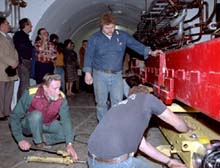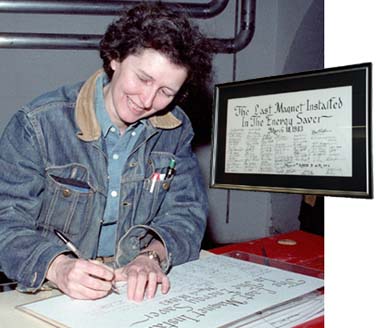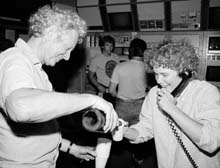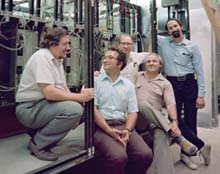|
1983—The Year the Tevatron Came to Life
by Kurt Riesselmann
It was the weekend before the Fourth of July. While the nation was preparing for another national holiday, accelerator experts at Fermilab worked around the clock to push the Energy Doubler—now known as the Tevatron—to new limits. The weather did not cooperate. A lightning bolt struck a Tevatron service building at 3 a.m., damaging enough sensitive electronics to cause six hours of diagnosis and repair. More lightning-induced trips took place the next morning. The following night, torrential rains flooded the site, and water found its way into some electronics racks.
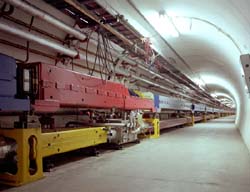 | | When installed, the new Tevatron accelerator fit tightly underneath the existing Main Ring accelerator. In 1997, the older accelerator was dismantled and its magnets reused in the Main Injector accelerator. |
Fermilab's scientists and technicians persisted. On Sunday morning, July 3, at 2 a.m., beam operators made the first serious attempt to accelerate beam in the Tevatron. In a second attempt on Sunday afternoon, at 3:37 p.m., they succeeded, achieving record beam energy of 512 GeV. "News of this historic achievement spread rapidly—by telephone and telex to all quarters of the world," the late physicist Thornton Murphy wrote in Ferminews in July of 1983. "The Control Room rapidly filled with off-shift workers and other well-wishers as the champagne was broken out."
The achievement paved the way to many great things: a spectacular lab-wide party that saw Director Leon Lederman dancing with Big Bird, an Open House for Fermilab's neighbors, and—finally—the start-up of the Tevatron fixed-target program on October 1 (with only 26 hours of beam delivered in that first month). A few months later the Tevatron pushed the world record to 800 GeV, doubling the energy of its predecessor, the Main Ring accelerator.
All along, the lab worked toward its most ambitious goal: the operation of the Tevatron as a proton-antiproton collider. From the construction of quadrupole magnets to the groundbreaking for the Antiproton Source to work on the first collider detector, the lab made progress.
"What we are witnessing is the gradual restoration of Fermilab as an operating laboratory," Lederman conveyed in the 1983 annual report. "There is a revival of spirit that comes from doing physics again—a new—old sweetness of mood. Even the complaints are a joy."
Twenty years later, the complaints are forgotten. But we will always remember how the Tevatron came to life.

At the 512 GeV party on July 8, 1983, founding director Robert Wilson celebrated the Tevatron, his vision turned reality. |
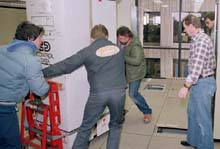
To handle the amount of expected data, Fermilab installed new computers on the seventh floor of Wilson Hall in Fall of 1983. |
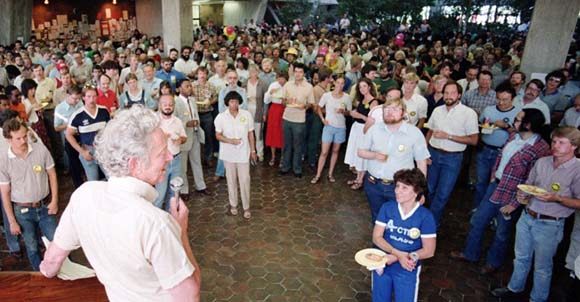
Leon Lederman addresses lab employees at a lab-wide celebration of the 512 GeV record. Fermilab employed almost 2,000 people in 1983.
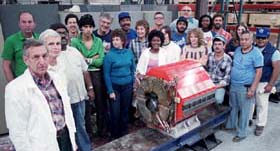
Technicians with the first quadrupole magnet for the Tevatron collider program. Collider operations began in 1985. |

A welder works on the Tevatron. | 
An electrician installs power for the Tevatron. |
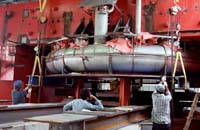
Fixed-target experiment E665 featured the large Chicago cyclotron magnet. The New Muon Building, which houses the magnet to this day, was built around the magnet. |
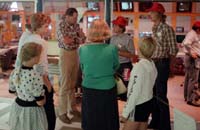
At an Open House on September 18, 1983, friends and neighbors learned more about Fermilab's new accelerator. Here visitors are talking to employees at the Main Control Room. |

Construction of the beam line to the Meson Laboratory, where some of the first Tevatron fixed-target experiments took place in Fall
of 1983. |

Guided by Rich Orr (right), Secretary of
Energy Donald Hodel takes a tour of the Tevatron tunnel in February of 1983.
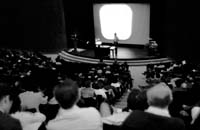
Some things never change: Annual Users Meeting at Fermilab in 1983.
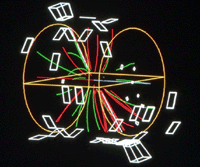
A 1983 computer simulation of proton-antiproton collision in the CDF detector.
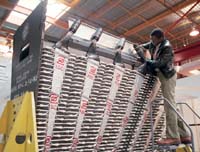
An employee installs a photo multiplier tube in a calorimeter unit for the CDF detector.
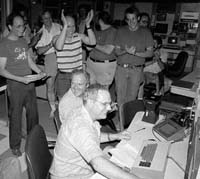
The Main Control Room on Sunday, July 3, at 3:37 p.m. as the Tevatron accelerated protons to 512 GeV, a new world record for accelerators.
|
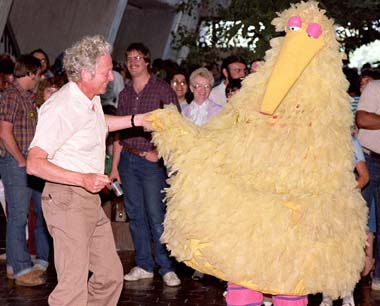
Crazy times in 1983: Leon Lederman dancing with Big Bird at the 512 GeV party.
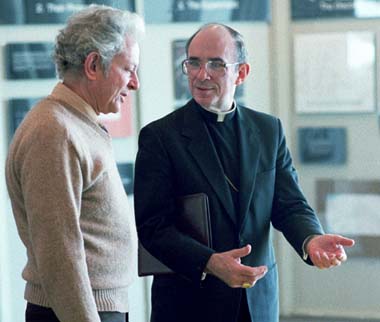
Did the Tevatron get a blessing? Cardinal Joseph Bernardin (right, next to Leon Lederman) visited the lab in April 1983.
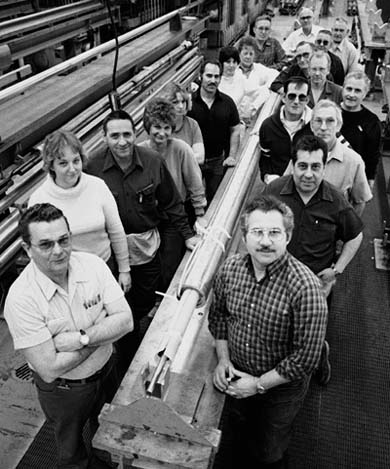
In March of 1983, technicians completed the last collared dipole coil for the Tevatron.
|

|


